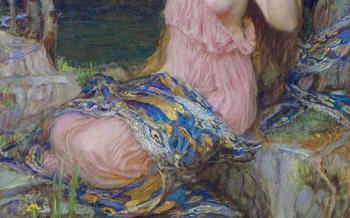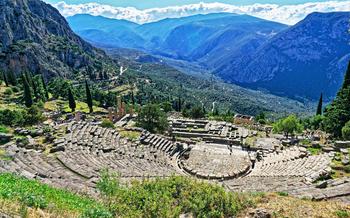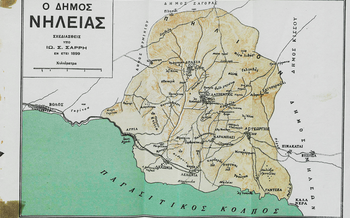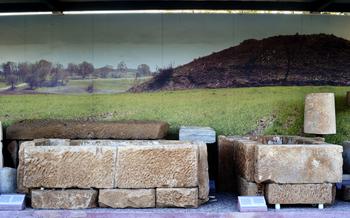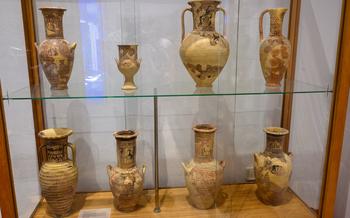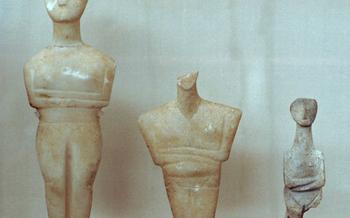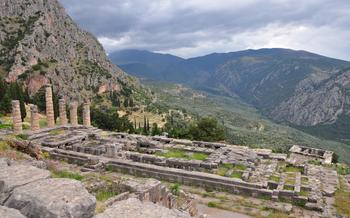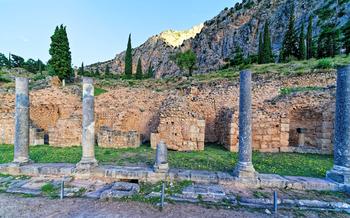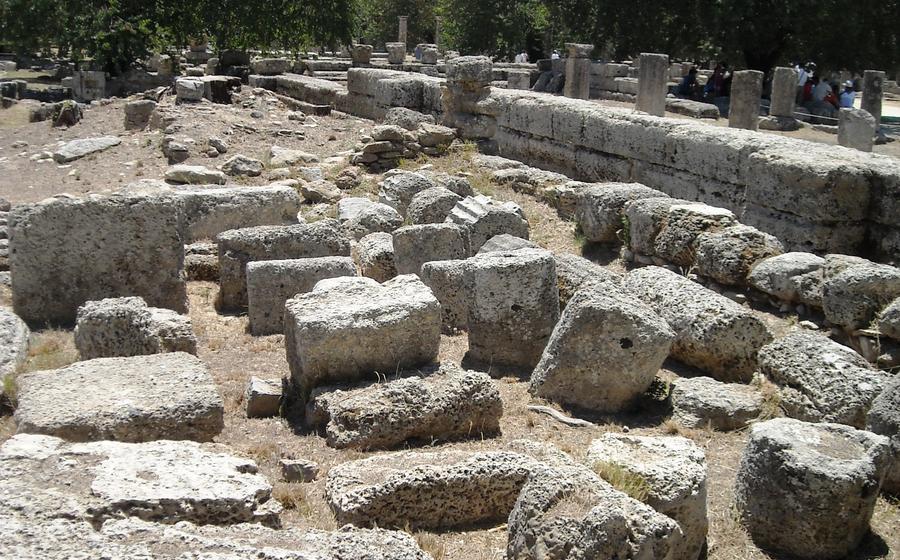
Ancient Lepreon
- Unveiling the Ancient Wonder: A Journey to Lepreon
- Tracing the Footsteps of History: Lepreon's Enduring Legacy
- Exploring the Ruins of Lepreon: A Glimpse into a Bygone Era
- The Ancient Theater: A Stage for Performances and Civic Life
- The Temple of Apollo: A Sanctuary of Worship and Reverence
- The Agora: The Heart of Commerce and Social Interaction
- The Sanctuary of Asclepius: A Haven for Healing and Hope
- Lepreon Museum: A Treasure-Trove of Ancient Artifacts
- Panoramic Views from the Acropolis: Awe-Inspiring Landscapes
- Trekking Through History: Hiking Trails Around Lepreon
- Local Delights: Culinary Experiences in Lepreon
- Events and Festivals: Celebrating Lepreon's Heritage
- Accommodation Options: Resting in the Heart of History
- Insider Tip: Unveiling Hidden Gems
Unveiling the Ancient Wonder: A Journey to Lepreon
Nestled in the heart of the Peloponnese region, the ancient city of Lepreon stands as a testament to the rich history and cultural heritage of Greece. Once a thriving city-state, Lepreon boasts an impressive collection of archaeological treasures that transport visitors back in time. Its strategic location, nestled among rolling hills and fertile valleys, made it a significant center of trade and culture in ancient times. Today, Lepreon offers a unique opportunity to explore the ruins of a once-great city and uncover the secrets of its fascinating past.
Must-see attractions:
- The ancient theater, with its well-preserved seating tiers and stunning acoustics.
- The Temple of Apollo, dedicated to the god of music and healing, showcasing exquisite architectural details.
- The Agora, the bustling marketplace where commercial and social activities thrived.
- The Gymnasium, a center for physical and intellectual pursuits, featuring training facilities and philosophical schools.
- The Sanctuary of Asclepius, a sacred healing center dedicated to the god of medicine, offering rituals and treatments.
Tracing the Footsteps of History: Lepreon's Enduring Legacy
Lepreon's origins can be traced back to the Bronze Age, when it was a small settlement known as Lepreos. Over time, it grew in size and importance, becoming a prominent city-state in ancient Greece. Lepreon's strategic location on the fertile Messenian plain and its proximity to the sea contributed to its prosperity and influence.
Throughout its history, Lepreon played a significant role in various wars and conflicts. In the 5th century BC, it joined the Peloponnesian League, an alliance of Greek city-states led by Sparta. During the Peloponnesian War, Lepreon remained loyal to Sparta and fought against Athens. The city also participated in the Messenian Wars, a series of conflicts between Sparta and Messenia, a neighboring region.
Lepreon's rich history is intertwined with numerous myths and legends. According to one myth, the city was founded by Lepreus, a son of the Arcadian hero Pelops. Another legend tells of a battle between Heracles, the mythical hero, and the Centaurs, half-human, half-horse creatures, which took place near Lepreon. These myths and legends add to the city's allure and mystique.
In the 4th century BC, Lepreon was conquered by the Macedonians under Alexander the Great. After Alexander's death, the city came under the control of various Hellenistic kingdoms, including the Ptolemies and the Seleucids. In the 2nd century BC, Lepreon joined the Achaean League, a federation of Greek city-states that opposed Macedonian rule.
The city's decline began in the 1st century BC when it was conquered by the Romans. Under Roman rule, Lepreon lost its independence and became part of the Roman province of Achaia. The city continued to exist during the Byzantine period, but its importance gradually diminished. In the 13th century AD, Lepreon was abandoned and fell into ruins.
The excavations and discoveries at Lepreon have shed light on the city's rich history and culture. Archaeologists have uncovered impressive fortifications, well-preserved temples, public buildings, and intriguing remnants of everyday life. These findings have helped us to understand the urban planning and architecture of ancient Greek cities.
Exploring the Ruins of Lepreon: A Glimpse into a Bygone Era
The ruins of Lepreon stand as a testament to the city's rich history and architectural prowess. Explore the impressive fortifications that once protected the city from invaders, marvel at the well-preserved temples and public buildings that showcase the city's grandeur, and discover intriguing remnants of everyday life that provide a glimpse into the daily routines of Lepreon's ancient inhabitants. These ruins offer a unique opportunity to understand ancient Greek architecture and urban planning, revealing the ingenuity and creativity of this ancient civilization.
The Ancient Theater: A Stage for Performances and Civic Life
Nestled amidst the ruins of Lepreon, the ancient theater stands as a testament to the city's rich cultural and civic life. Constructed in the 4th century BC, the theater boasts impressive architectural features and a well-preserved seating area that once accommodated up to 1,500 spectators. Its remarkable acoustics, achieved through careful design and placement, ensured that every word uttered on stage could be heard throughout the auditorium.
The theater served as a venue for a variety of performances, including dramas, comedies, and musical recitals. These events were not merely entertainment but also played a significant role in religious ceremonies and civic events. During festivals honoring Dionysus, the god of theater and wine, the theater hosted elaborate performances that celebrated his divine power and brought the community together.
In addition to theatrical productions, the theater was also used for public assemblies, political debates, and the announcement of important civic decisions. It was a place where citizens could engage in discussions, voice their opinions, and participate in the decision-making process that shaped the city's future.
Today, the ancient theater of Lepreon stands as a silent witness to the vibrant cultural and civic life that once flourished within its walls. Its enduring presence serves as a reminder of the importance of the arts, community engagement, and the enduring legacy of ancient Greek culture.
The Temple of Apollo: A Sanctuary of Worship and Reverence
Amidst the ruins of Lepreon, the Temple of Apollo stands as a testament to the city's religious devotion and architectural prowess. Constructed in the 6th century BC, the temple was dedicated to the revered god Apollo, who was worshipped as the protector of the city. Its imposing presence and intricate design make it one of the most significant landmarks in Lepreon.
The temple's architectural style reflects the transition from the Archaic to the Classical period. Constructed from local limestone, it features a rectangular plan with a cella, or inner chamber, surrounded by a colonnade. The cella housed a cult statue of Apollo, which was the focal point of religious ceremonies and offerings.
Excavations at the site have unearthed a wealth of artifacts and offerings, providing valuable insights into the religious practices of ancient Lepreon. These include votive offerings such as pottery, bronze figurines, and jewelry, as well as inscriptions that shed light on the rituals and beliefs associated with Apollo's cult.
The temple's connection to the cult of Apollo had a profound influence on Lepreon's religious practices. Apollo was revered as the god of healing, prophecy, and music, and his worship was central to the city's religious life. The temple served as a place of pilgrimage for both locals and visitors seeking guidance, healing, or divine inspiration.
The Agora: The Heart of Commerce and Social Interaction
The bustling agora, or marketplace, lay at the heart of ancient Lepreon, serving as a vibrant hub of commercial activity and social interaction. Enclosed by colonnaded porticoes, the agora provided shelter from the elements and created a sheltered space for merchants to display their wares and buyers to browse and haggle.
Within the agora, a variety of shops and stalls lined the walkways, offering an array of goods to meet the needs of the community. Artisans displayed their handcrafted pottery, jewelry, and textiles, while farmers sold fresh produce and livestock. Merchants from distant lands brought exotic imports, such as spices, perfumes, and fabrics, adding to the cosmopolitan atmosphere of the marketplace.
Beyond commercial transactions, the agora served as a crucial social gathering place. Citizens from all walks of life converged here to exchange news, discuss politics, and engage in lively debates. Philosophers and poets recited their works, attracting crowds of eager listeners. Religious festivals and civic events were also held in the agora, further enhancing its significance as a focal point of community life.
The agora's layout and architecture reflected its multifaceted role. The central area was reserved for commercial activities, with shops and stalls arranged in orderly rows. Surrounding the marketplace were public buildings, including temples, government offices, and meeting halls. These structures not only provided essential services but also added to the grandeur and prestige of the agora.
Exploring the ruins of the agora today, visitors can still sense the vibrant atmosphere that once permeated this ancient marketplace. The well-preserved foundations and remnants of shops and public buildings offer a glimpse into the bustling commercial and social activities that took place here. The agora stands as a testament to the importance of commerce and social interaction in ancient Greek society.
The Sanctuary of Asclepius: A Haven for Healing and Hope
In the heart of ancient Lepreon, nestled amidst the ruins of a once-thriving city, lies a sacred sanctuary dedicated to the revered deity of healing, Asclepius. This sanctuary served as a beacon of hope for those seeking solace and rejuvenation, offering a sanctuary for both body and soul.
The Sanctuary of Asclepius was a testament to the ancient Greeks' profound belief in the power of healing. Asclepius, the son of the god Apollo, was renowned for his exceptional medical skills and his ability to cure the sick and injured. His sanctuary in Lepreon was a place where the sick and infirm could come to seek his divine intervention and receive healing treatments.
The sanctuary comprised a temple, altars, and various facilities dedicated to the healing arts. Within the temple, a statue of Asclepius stood majestically, radiating an aura of compassion and healing power. Devotees would offer prayers, sacrifices, and votive offerings to the deity, seeking his favor and seeking relief from their ailments.
The sanctuary also housed a number of healing facilities, including baths, massage rooms, and specialized chambers for various medical treatments. Trained healers, known as Asclepiads, were on hand to administer treatments and provide medical advice to those in need.
The Sanctuary of Asclepius played a vital role in the healthcare system of ancient Greece, serving as a center of medical knowledge and innovation. It was a place where patients could receive treatment for a wide range of illnesses and injuries, and where new medical techniques were developed and refined.
Today, the ruins of the Sanctuary of Asclepius stand as a testament to the enduring legacy of healing and hope that this sacred site once represented. Visitors can explore the remains of the temple, altars, and healing facilities, and immerse themselves in the atmosphere of reverence and devotion that once permeated this ancient sanctuary.
Lepreon Museum: A Treasure-Trove of Ancient Artifacts
Nestled in the heart of Lepreon, the Lepreon Museum stands as a testament to the city's rich history and cultural heritage. Within its walls, visitors embark on a journey through time, encountering a treasure-trove of ancient artifacts that bring the past to life.
The museum's collection is a diverse tapestry of objects, each telling a unique story about Lepreon's vibrant past. From intricately carved sculptures and pottery to bronze tools and coins, the exhibits offer a glimpse into the daily lives, artistic expressions, and technological achievements of the city's ancient inhabitants.
Among the highlights of the collection are the exquisitely crafted marble statues of gods and goddesses, their serene expressions and flowing robes inviting visitors to connect with the spiritual beliefs of ancient Lepreon. Equally captivating are the intricate mosaics that once adorned the floors of wealthy homes, their colorful tiles depicting scenes from mythology and everyday life.
Interactive displays and educational resources enhance the museum experience, providing visitors with deeper insights into the history and significance of the artifacts. Through touchscreens, audio guides, and hands-on activities, visitors can explore the ancient world in a truly immersive and engaging way.
The Lepreon Museum is not merely a repository of artifacts; it is a living testament to the enduring legacy of this ancient city. Its collection serves as a reminder of the creativity, ingenuity, and resilience of the people who once called Lepreon home.
Panoramic Views from the Acropolis: Awe-Inspiring Landscapes
Location and accessibility The acropolis of Lepreon is strategically positioned on a hill overlooking the city and the surrounding countryside. Visitors can easily reach the acropolis by following a well-marked hiking trail that leads up from the town center. The trail offers stunning views along the way and provides a great opportunity to stretch your legs and immerse yourself in the beauty of the natural surroundings.
Breathtaking views Once you reach the summit of the acropolis, you will be rewarded with breathtaking panoramic views that will take your breath away. To the north, you can gaze upon the lush green valleys and rolling hills of the Peloponnese, dotted with olive groves and vineyards. To the south, you can admire the sparkling blue waters of the Mediterranean Sea, stretching as far as the eye can see. The views from the acropolis are truly awe-inspiring and offer a unique perspective on the region's geography and history.
Historical significance The acropolis of Lepreon served as a defensive stronghold in ancient times, protecting the city from invaders and marauders. The remains of the city's fortifications, including sturdy walls and towers, can still be seen today, providing a glimpse into the strategic importance of the site. The acropolis also played a significant role in religious ceremonies and rituals, with temples and altars dedicated to various deities located within its sacred precincts.
Importance of the acropolis The acropolis of Lepreon is not only a natural vantage point but also a significant historical site that offers insights into the city's past. It is a place where visitors can connect with the ancient world and experience the grandeur and beauty of Lepreon's rich heritage. Whether you are a history buff, a nature lover, or simply someone who appreciates stunning views, the acropolis is a must-visit destination that should not be missed.
Trekking Through History: Hiking Trails Around Lepreon
Venture beyond the ancient ruins and explore the picturesque landscapes surrounding Lepreon on foot. Hiking trails of varying difficulty levels wind through the countryside, offering breathtaking views, historical sites, and natural wonders.
Lace up your hiking boots and embark on the well-marked trail leading to the summit of Mount Likovouno. The moderate ascent rewards you with panoramic vistas of the Ionian Sea, the lush valleys, and the distant mountains. Along the way, discover remnants of ancient fortifications and settlements, hinting at the region's rich past.
For a more challenging hike, tackle the trail to the Neda Gorge. This rugged path takes you through dense forests, past cascading waterfalls, and along the crystal-clear waters of the Neda River. Marvel at the towering cliffs, carved by centuries of erosion, and spot rare flora and fauna that thrive in this unique ecosystem.
If you prefer a leisurely stroll, meander along the coastal path that hugs the stunning Ionian coastline. Inhale the invigorating sea breeze as you pass secluded coves, sandy beaches, and charming fishing villages. The trail offers panoramic views of the azure waters and the neighboring islands.
Remember to pack sturdy footwear, water, and snacks for your hiking adventures. Respect the environment and leave no trace behind. Whether you're an experienced hiker or a nature enthusiast, Lepreon's hiking trails promise an unforgettable and enriching experience, connecting you with the region's history, culture, and natural beauty.
Local Delights: Culinary Experiences in Lepreon
Indulge in the culinary delights of Lepreon and savor the authentic flavors of traditional Greek cuisine. Sample regional specialties, such as the hearty lamb stew with fresh herbs, or the succulent grilled octopus drizzled with olive oil and lemon. Delight in the freshness of locally sourced ingredients, from the plump tomatoes and crisp cucumbers to the juicy olives and aromatic herbs.
For a memorable dining experience, venture into the heart of Lepreon and seek out traditional tavernas. Immerse yourself in the lively atmosphere, where locals and visitors gather to share stories and laughter over delicious food. Enjoy the warm hospitality of the owners, who take pride in preparing each dish with care and passion.
Explore the local markets, where vendors display an array of fresh produce, spices, and handmade delicacies. Engage with the friendly locals as they share their culinary secrets and help you select the finest ingredients for your own culinary creations. Participate in a cooking class or workshop to learn the art of Greek cuisine and bring a taste of Lepreon back home with you.
Must-Try Dishes:
-
Moussaka: A hearty casserole of eggplant, potatoes, and minced meat, topped with a creamy béchamel sauce.
-
Souvlaki: Grilled skewers of marinated meat, served with pita bread, tzatziki sauce, and fresh vegetables.
-
Gemista: Stuffed tomatoes and peppers with rice, herbs, and minced meat, baked in a rich tomato sauce.
-
Baklava: Layers of filo pastry filled with chopped nuts and sweetened with honey syrup.
Events and Festivals: Celebrating Lepreon's Heritage
Lepreon's cultural heritage comes alive during its annual festivals and events. These celebrations offer a glimpse into the city's rich history and traditions, providing visitors with an opportunity to immerse themselves in the vibrant local culture.
One of the most notable events is the annual Lepreon Festival, held in the summer months. This festival showcases the city's culinary delights, traditional music, and dance performances. Visitors can indulge in delicious Greek dishes, enjoy live music and dancing, and witness traditional costumes and customs.
Religious celebrations also play a significant role in Lepreon's cultural calendar. The city's patron saint, Saint John the Baptist, is honored with a grand procession and festivities on his feast day. Locals and visitors alike gather to witness the procession, which features elaborate floats, traditional costumes, and religious icons.
Throughout the year, Lepreon hosts various cultural events, including art exhibitions, theater performances, and concerts. These events provide a platform for local artists and performers to showcase their talents and share their stories with the community.
Attending these events and festivals is an excellent way to experience the true essence of Lepreon and connect with its people. Visitors can immerse themselves in the city's rich cultural heritage, celebrate its traditions, and create lasting memories.
Accommodation Options: Resting in the Heart of History
Lepreon offers a range of accommodation options to suit every traveler's preference and budget. From charming guesthouses to modern hotels, there's something for every kind of visitor. Each accommodation offers unique amenities and facilities, ensuring a comfortable and memorable stay. Whether you seek a traditional Greek experience or modern conveniences, you'll find it here. For those on a budget, there are affordable hostels and guesthouses that offer a friendly and social atmosphere. For a more luxurious experience, there are boutique hotels and resorts that provide stunning views, private pools, and top-notch amenities. No matter your choice, you'll be in the heart of history, surrounded by ancient ruins and picturesque landscapes.
Insider Tip: To truly soak in the local culture, consider staying in a traditional Greek guesthouse. These family-run establishments often offer personalized service, delicious home-cooked meals, and a warm, welcoming atmosphere. It's a unique opportunity to connect with the locals and experience the true essence of Lepreon.
Insider Tip: Unveiling Hidden Gems
Beyond the main attractions, Lepreon holds secret spots and lesser-known gems waiting to be discovered. Venture off the beaten path to uncover hidden treasures that offer unique perspectives into the city's past. Ask locals for recommendations on secluded beaches, charming hiking trails, or traditional tavernas serving authentic Greek cuisine. Explore the surrounding countryside, where you might stumble upon ancient ruins, picturesque villages, or breathtaking natural landscapes. Embrace the opportunity to immerse yourself in the true essence of Lepreon and create unforgettable memories.
